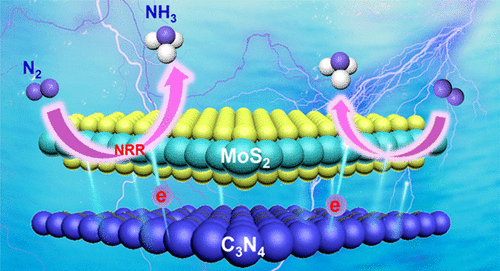当前位置:
X-MOL 学术
›
ACS Appl. Mater. Interfaces
›
论文详情
Our official English website, www.x-mol.net, welcomes your
feedback! (Note: you will need to create a separate account there.)
Two-dimensional (2D)/2D Interface Engineering of a MoS2/C3N4 Heterostructure for Promoted Electrocatalytic Nitrogen Fixation.
ACS Applied Materials & Interfaces ( IF 8.3 ) Pub Date : 2020-01-30 , DOI: 10.1021/acsami.9b18263 Ke Chu 1 , Ya-Ping Liu 1 , Yu-Biao Li 1 , Ya-Li Guo 1 , Ye Tian 2
ACS Applied Materials & Interfaces ( IF 8.3 ) Pub Date : 2020-01-30 , DOI: 10.1021/acsami.9b18263 Ke Chu 1 , Ya-Ping Liu 1 , Yu-Biao Li 1 , Ya-Li Guo 1 , Ye Tian 2
Affiliation

|
The electrochemical nitrogen reduction reaction (NRR) is a very efficient method for sustainable NH3 production, but it requires effective catalysts to expedite the NRR kinetics and inhibit the concomitant hydrogen evolution reaction (HER). Two-dimensional (2D)/2D interface engineering is an effective method to design powerful catalysts due to intimate face-to-face contact of two 2D materials that facilitates the strong interfacial electronic interactions. Herein, we explored a 2D/2D MoS2/C3N4 heterostructure as an active and stable NRR catalyst. MoS2/C3N4 exhibited a conspicuously improved NRR performance with an NH3 yield of 18.5 μg h-1 mg-1 and a high Faradaic efficiency (FE) of 17.8% at -0.3 V, far better than those of the individual MoS2 or C3N4 component. Density functional theory calculations revealed that the interfacial charge transport from C3N4 to MoS2 could enhance the NRR activity of MoS2/C3N4 by promoting the stabilization of the key intermediate *N2H on Mo edge sites of MoS2 and concurrently decreasing the reaction energy barrier. Meanwhile, MoS2/C3N4 rendered a more favorable *H adsorption free energy on S edge sites than on Mo edge sites of MoS2, thereby protecting the NRR-active Mo edge sites from the competing HER and leading to a high FE.
中文翻译:

MoS2 / C3N4异质结构用于促进电催化固氮的二维(2D)/ 2D接口工程。
电化学氮还原反应(NRR)是可持续生产NH3的一种非常有效的方法,但它需要有效的催化剂来加快NRR动力学并抑制伴随的氢释放反应(HER)。二维(2D)/ 2D接口工程是设计强大催化剂的有效方法,这是由于两种2D材料的紧密面对面接触而形成的,从而促进了强界面电子相互作用。在本文中,我们探索了2D / 2D MoS2 / C3N4异质结构作为活性和稳定的NRR催化剂。MoS2 / C3N4表现出显着改善的NRR性能,NH3产量为18.5μgh-1 mg-1,在-0.3 V时的法拉第效率(FE)为17.8%,远好于单个MoS2或C3N4组分。密度泛函理论计算表明,从C3N4到MoS2的界面电荷传输可以通过促进MoS2的Mo边缘位点上关键中间体* N2H的稳定化并同时降低反应能垒来增强MoS2 / C3N4的NRR活性。同时,与在MoS2的Mo边缘部位上相比,MoS2 / C3N4在S边缘部位上提供了更有利的* H吸附自由能,从而保护了具有NRR活性的Mo边缘部位免受竞争性HER的侵害并导致高FE。
更新日期:2020-01-31
中文翻译:

MoS2 / C3N4异质结构用于促进电催化固氮的二维(2D)/ 2D接口工程。
电化学氮还原反应(NRR)是可持续生产NH3的一种非常有效的方法,但它需要有效的催化剂来加快NRR动力学并抑制伴随的氢释放反应(HER)。二维(2D)/ 2D接口工程是设计强大催化剂的有效方法,这是由于两种2D材料的紧密面对面接触而形成的,从而促进了强界面电子相互作用。在本文中,我们探索了2D / 2D MoS2 / C3N4异质结构作为活性和稳定的NRR催化剂。MoS2 / C3N4表现出显着改善的NRR性能,NH3产量为18.5μgh-1 mg-1,在-0.3 V时的法拉第效率(FE)为17.8%,远好于单个MoS2或C3N4组分。密度泛函理论计算表明,从C3N4到MoS2的界面电荷传输可以通过促进MoS2的Mo边缘位点上关键中间体* N2H的稳定化并同时降低反应能垒来增强MoS2 / C3N4的NRR活性。同时,与在MoS2的Mo边缘部位上相比,MoS2 / C3N4在S边缘部位上提供了更有利的* H吸附自由能,从而保护了具有NRR活性的Mo边缘部位免受竞争性HER的侵害并导致高FE。


















































 京公网安备 11010802027423号
京公网安备 11010802027423号